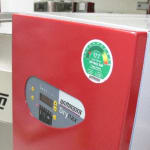 Wittmann has introduced a comprehensive testing program to establish energy ratings for their Drymax dry air dryers. The familiar topic of energy efficiency and energy savings is commonly put forth by many suppliers as a sales argument but what are their claims really based on and can they be substantiated? After several years of research, Wittmann has developed a standardized rating method based on stringent test conditions that provide repeatable results for the actual energy use.
Wittmann has introduced a comprehensive testing program to establish energy ratings for their Drymax dry air dryers. The familiar topic of energy efficiency and energy savings is commonly put forth by many suppliers as a sales argument but what are their claims really based on and can they be substantiated? After several years of research, Wittmann has developed a standardized rating method based on stringent test conditions that provide repeatable results for the actual energy use.
Optimizing and minimizing energy consumption is just one step towards preventing climate change. In terms of resin drying, energy represents a big portion of the cost. Although Drymax dryers are provided with many standard energy saving features like insulated stainless steel hoppers, SmartReg, 7-day timer and SmartFlow for multiple hopper units, the largest amount of energy is used to heat the resin and remove moisture. For this reason, one must begin by looking at the initial moisture content of the resin and the ambient conditions.

To further test the validity of their results, Wittmann compared actual test results with theoretical values. Once tested, every dryer model will be labeled with an Energy Sticker showing the measured test result in terms of kWh per unit weight of dry air. Processors buying a dryer based on energy efficiency or energy savings should ask the supplier for the actual test data and then have them explain how it was measured. If they can`t or are unwilling to provide this information then you must ask yourself about the value of the data in making any meaningful comparison.


